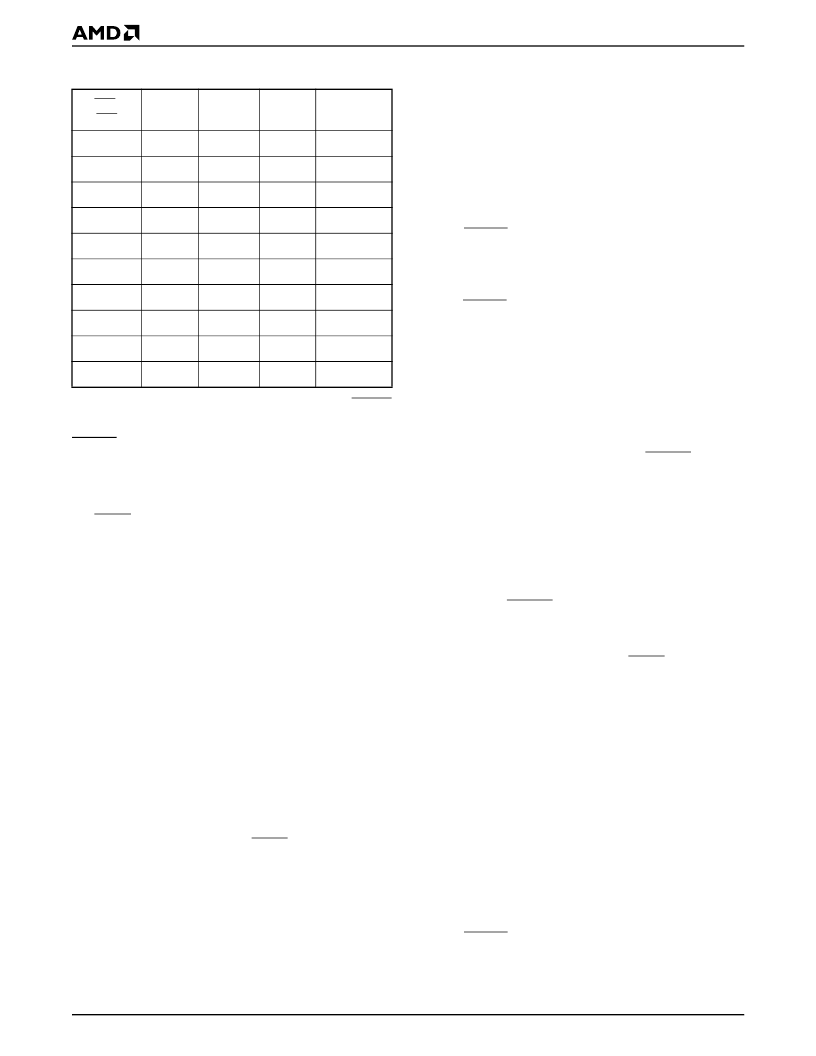- 您現(xiàn)在的位置:買(mǎi)賣(mài)IC網(wǎng) > PDF目錄366550 > Am79C965A (Advanced Micro Devices, Inc.) PCnet?-32 Single-Chip 32-Bit Ethernet Controller PDF資料下載
參數(shù)資料
| 型號(hào): | Am79C965A |
| 廠商: | Advanced Micro Devices, Inc. |
| 英文描述: | PCnet?-32 Single-Chip 32-Bit Ethernet Controller |
| 中文描述: | PCnet?-32單芯片32位以太網(wǎng)控制器 |
| 文件頁(yè)數(shù): | 38/228頁(yè) |
| 文件大小: | 1681K |
| 代理商: | AM79C965A |
第1頁(yè)第2頁(yè)第3頁(yè)第4頁(yè)第5頁(yè)第6頁(yè)第7頁(yè)第8頁(yè)第9頁(yè)第10頁(yè)第11頁(yè)第12頁(yè)第13頁(yè)第14頁(yè)第15頁(yè)第16頁(yè)第17頁(yè)第18頁(yè)第19頁(yè)第20頁(yè)第21頁(yè)第22頁(yè)第23頁(yè)第24頁(yè)第25頁(yè)第26頁(yè)第27頁(yè)第28頁(yè)第29頁(yè)第30頁(yè)第31頁(yè)第32頁(yè)第33頁(yè)第34頁(yè)第35頁(yè)第36頁(yè)第37頁(yè)當(dāng)前第38頁(yè)第39頁(yè)第40頁(yè)第41頁(yè)第42頁(yè)第43頁(yè)第44頁(yè)第45頁(yè)第46頁(yè)第47頁(yè)第48頁(yè)第49頁(yè)第50頁(yè)第51頁(yè)第52頁(yè)第53頁(yè)第54頁(yè)第55頁(yè)第56頁(yè)第57頁(yè)第58頁(yè)第59頁(yè)第60頁(yè)第61頁(yè)第62頁(yè)第63頁(yè)第64頁(yè)第65頁(yè)第66頁(yè)第67頁(yè)第68頁(yè)第69頁(yè)第70頁(yè)第71頁(yè)第72頁(yè)第73頁(yè)第74頁(yè)第75頁(yè)第76頁(yè)第77頁(yè)第78頁(yè)第79頁(yè)第80頁(yè)第81頁(yè)第82頁(yè)第83頁(yè)第84頁(yè)第85頁(yè)第86頁(yè)第87頁(yè)第88頁(yè)第89頁(yè)第90頁(yè)第91頁(yè)第92頁(yè)第93頁(yè)第94頁(yè)第95頁(yè)第96頁(yè)第97頁(yè)第98頁(yè)第99頁(yè)第100頁(yè)第101頁(yè)第102頁(yè)第103頁(yè)第104頁(yè)第105頁(yè)第106頁(yè)第107頁(yè)第108頁(yè)第109頁(yè)第110頁(yè)第111頁(yè)第112頁(yè)第113頁(yè)第114頁(yè)第115頁(yè)第116頁(yè)第117頁(yè)第118頁(yè)第119頁(yè)第120頁(yè)第121頁(yè)第122頁(yè)第123頁(yè)第124頁(yè)第125頁(yè)第126頁(yè)第127頁(yè)第128頁(yè)第129頁(yè)第130頁(yè)第131頁(yè)第132頁(yè)第133頁(yè)第134頁(yè)第135頁(yè)第136頁(yè)第137頁(yè)第138頁(yè)第139頁(yè)第140頁(yè)第141頁(yè)第142頁(yè)第143頁(yè)第144頁(yè)第145頁(yè)第146頁(yè)第147頁(yè)第148頁(yè)第149頁(yè)第150頁(yè)第151頁(yè)第152頁(yè)第153頁(yè)第154頁(yè)第155頁(yè)第156頁(yè)第157頁(yè)第158頁(yè)第159頁(yè)第160頁(yè)第161頁(yè)第162頁(yè)第163頁(yè)第164頁(yè)第165頁(yè)第166頁(yè)第167頁(yè)第168頁(yè)第169頁(yè)第170頁(yè)第171頁(yè)第172頁(yè)第173頁(yè)第174頁(yè)第175頁(yè)第176頁(yè)第177頁(yè)第178頁(yè)第179頁(yè)第180頁(yè)第181頁(yè)第182頁(yè)第183頁(yè)第184頁(yè)第185頁(yè)第186頁(yè)第187頁(yè)第188頁(yè)第189頁(yè)第190頁(yè)第191頁(yè)第192頁(yè)第193頁(yè)第194頁(yè)第195頁(yè)第196頁(yè)第197頁(yè)第198頁(yè)第199頁(yè)第200頁(yè)第201頁(yè)第202頁(yè)第203頁(yè)第204頁(yè)第205頁(yè)第206頁(yè)第207頁(yè)第208頁(yè)第209頁(yè)第210頁(yè)第211頁(yè)第212頁(yè)第213頁(yè)第214頁(yè)第215頁(yè)第216頁(yè)第217頁(yè)第218頁(yè)第219頁(yè)第220頁(yè)第221頁(yè)第222頁(yè)第223頁(yè)第224頁(yè)第225頁(yè)第226頁(yè)第227頁(yè)第228頁(yè)

38
Am79C965A
Table 15. Byte Duplication on Data Bus
*
Note:
Byte duplication does not apply during a LBS16
access. See Table 8.
EADS
External Address Strobe
During master write accesses in which Generate
Cache Invalidation Cycles mode has been selected,
the EADS pin will be asserted as part of the PCnet-32
controller cache invalidation cycle. Cache invalidation
cycles will occur as often as a new cache line is
reached. The cache line size can be set with the cache
line length bits of BCR18 (bits [15:11]).
HLDA
Bus Hold Acknowledge
PCnet-32 controller examines the HLDA signal to
determine when it has been granted ownership of the
bus. HLDA is active HIGH.
Output
Input
When HLDA is asserted and HOLD is being asserted
by the PCnet-32 controller, the PCnet-32 controller
assumes ownership of the local bus. However, if the
PCnet-32 controller is asserting HOLD because
HOLDI is asserted (as in a daisy chain arbitration), then
PCnet-32 controller will assert HLDAO and will not
assume ownership of the local bus.
Note that it changes polarity when the VL mode is se-
lected (see pin description of LGNT in VESA VL-Bus
Interface section).
HLDAO
Bus Hold Acknowledge Out
This signal is multiplexed with the TCK pin, and is avail-
able only when the Multi-Interrupt mode has been se-
lected with the JTAGSEL pin.
Output
An additional local bus master may daisy-chain its
HLDA signal through the PCnet-32 controller HLDAO
pin. The PCnet-32 controller will deliver a HLDAO
signal to the additional local bus master whenever the
PCnet-32 controller receives a HLDA from the CPU,
but is not simultaneously requesting the bus internally.
The second local bus master must connect its HOLD
output to the HOLDI input of the PCnet-32 controller in
order to complete the local bus daisy-chain arbitration
control.
When SLEEP is not asserted, daisy chain arbitration
signals that pass through the PCnet-32 controller will
experience a one-clock delay from input to output (i.e.
HOLDI to HOLD and HLDA to HLDAO).
While SLEEP is asserted (either in
snooze
mode or
coma
mode), if the PCnet-32 controller is configured
for a daisy chain (HOLDI and HLDAO signals have
been selected with the JTAGSEL pin), then the system
arbitration signal HLDA will be passed directly to the
daisy-chain signal HLDAO without experiencing a one-
clock delay. However, some combinatorial delay will be
introduced in this path.
Note that this pin changes polarity when VL mode has
been selected (see pin description of LGNTO in VESA
VL-Bus Interface section).
HOLD
Bus Hold Request
PCnet-32 controller asserts the HOLD pin as a signal
that it wishes to become the local bus master. HOLD is
active high. Once asserted, HOLD remains active until
HLDA has become active, independent of subsequent
assertion of SLEEP or setting of the STOP bit or
access to the S_RESET port (offset 14h).
Output
Note t hat this pin changes polarity when the VL mode
is selected (see pin description of LREQ in VESA VL-
Bus Interface section).
HOLDI
Bus Hold Request In
This signal is multiplexed with the TDO pin, and is
available only when the Multi-Interrupt mode has been
selected with the JTAGSEL pin.
Input
An additional local bus master may daisy-chain its bus
hold request signal through the PCnet-32 controller
HOLDI pin. The PCnet-32 controller will convey the
HOLDI request to the CPU via the PCnet-32 controller
HOLD output. The second local bus master must con-
nect its HLDA input to the HLDAO output of the
PCnet-32 controller in order to complete the local bus
daisy-chain arbitration control.
When SLEEP is not asserted, daisy chain arbitration
signals that pass through the PCnet-32 controller will
BE3-
BE0
DAT
[31:24]
DAT
[23:16]
DAT
[15:8]
DAT
[7:0]
1110
Undef
Undef
Undef
A
1101
Undef
Undef
A
Undef
1011
Undef
A
Undef
Copy A
0111
A
Undef
Copy A
Undef
1100
Undef
Undef
B
A
1001
Undef
C
B
Undef
0011*
D
C
Copy D
Copy C
1000
Undef
C
B
A
0001
D
C
B
Undef
0000
D
C
B
A
相關(guān)PDF資料 |
PDF描述 |
|---|---|
| AM79C970AKCW | PCnet-PCI II Single-Chip Full-Duplex Ethernet Controller for PCI Local Bus Product |
| AM79C970AKC | PCnet-PCI II Single-Chip Full-Duplex Ethernet Controller for PCI Local Bus Product |
| AM79C970A | PCnet-PCI II Single-Chip Full-Duplex Ethernet Controller for PCI Local Bus Product |
| AM79C970AVCW | PCnet-PCI II Single-Chip Full-Duplex Ethernet Controller for PCI Local Bus Product |
| AM79C970 | PCnetTM-PCI Single-Chip Ethernet Controller for PCI Local Bus |
相關(guān)代理商/技術(shù)參數(shù) |
參數(shù)描述 |
|---|---|
| AM79C965AWW WAF | 制造商:Advanced Micro Devices 功能描述: |
| AM79C970 | 制造商:AMD 制造商全稱:Advanced Micro Devices 功能描述:PCnetTM-PCI Single-Chip Ethernet Controller for PCI Local Bus |
| AM79C970A | 制造商:AMD 制造商全稱:Advanced Micro Devices 功能描述:PCnet-PCI II Single-Chip Full-Duplex Ethernet Controller for PCI Local Bus Product |
| AM79C970AKC | 制造商:AMD 制造商全稱:Advanced Micro Devices 功能描述:PCnet-PCI II Single-Chip Full-Duplex Ethernet Controller for PCI Local Bus Product |
發(fā)布緊急采購(gòu),3分鐘左右您將得到回復(fù)。